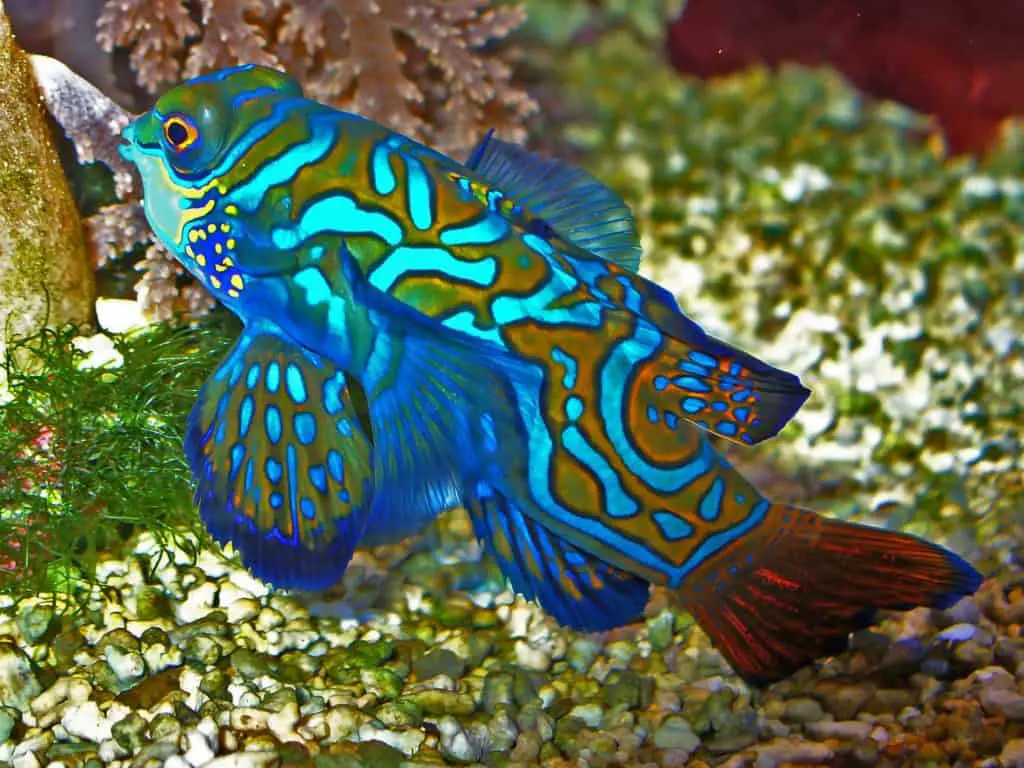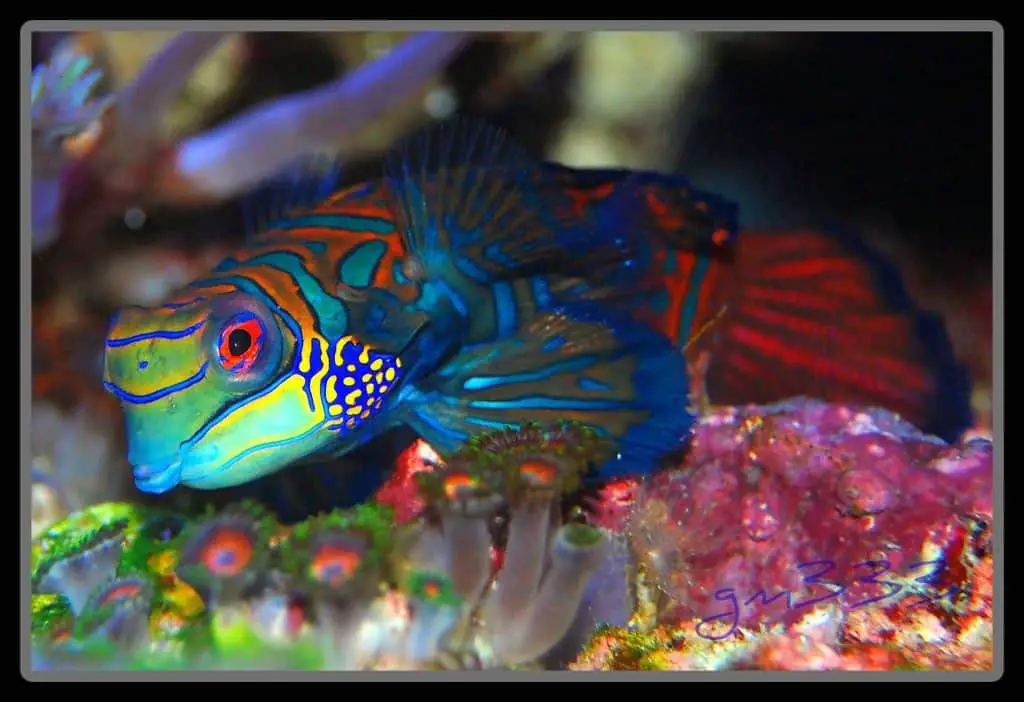The mandarin fish are also known as synchiropus splendidus which were first reported by 1927 by Albert William Herre are small but brightly colored member of the dragonet family. People who have been to aquariums have likely seen this distinctive fish and it’s easily spotted with a bright blue coloring and orange stripes.
This fish is difficult to keep although still very popular in the aquarium hobby.
Many people wonder, Where Does the Mandarin Fish Live? These fish are challenging to keep alive in an aquarium as it may not be possible to duplicate their home environment well.
Mandarin Fish are found in the western Pacific. This can include the Philippines, Indonesia, Australia, Indonesia, and New Guinea. The fish may also be found around the Ryukyo islands. They live in and around the reefs and coral outcrops in the Pacific Ocean.

Table of Contents
Where Does the Mandarin Fish Live?
Mandarin fish are tropical, marine fish. They prefer water that ranges from 24-26 degrees Celsius. They are mostly seen in coral reefs and shallow lagoons. Due to their extremely shy nature, the fish prefer to hide under dead coral and may be difficult to spot in their native environment.
The only time that they are seen in another environment is during spawning season when they may be spotted in the open ocean environment.
If looking for these fish, they are mostly found in the western Pacific. This can include the Philippines, Indonesia, Australia, Indonesia, and New Guinea. The fish may also be found around the Ryukyo islands.
Live rock available here from Marine Depot

Habitat and Preferred Environment
In the wild, these species tend to prefer inshore coral reefs or shallow areas. The bottom fins on the fish allow them to “walk” on the bottom of the ocean, and they prefer to blend into their environment.
The coral reef allows them to fit into the brightly colored area, allowing the fish to stay undetected. The waters that they prefer are both warm and alkaline. They prefer to be in areas where movement is minimal but plenty of light for them to enjoy.
In an aquarium setting, it can be challenging to mimic their preferred environment. The substrates used in a tank would be silt with corals, rocks, and other rubble that is set on top. A combination of these materials would be used to provide both food and shelter for the mandarin fish.
The reef habitat is probably the most common when it comes to tank setup. The live sand or another substrate that’s used to cover the bottom of the tank needs to be thick enough for the fish to bury themselves in. They rarely burry completely in the sand but normally make a small impression next to live rocks and use these as a means of escape.

Mandarin fish are easily stressed and will semi-burry themselves when the want to hide. On top of this material, there should be adequate rock and coral. This will be used to provide hiding spots for the mandarin fish to hide as well.
Mandarine Specialist Food available here!
Living rocks provide shelter and food
The live rock will actually serve as a food source. The rocks provide copepods which the mandarin fish prefer to eat. They need approximately 75 pounds of live rock in order to provide enough food for a single fish. This means that if the copepods are not well-established, the fish may starve.
Temperature is important in order to maintain a temperate environment for the fish. They also need to keep a pH of 8.1-8.4 for good health. They don’t need any specific lighting requirements so a standard light will be adequate.
Many aquarists use Refugiums as a source of filtration but also to grow live food sources for their mandarin fish. Live amphipods and copepods are a staple diet for all Mandarins. They grow within the refugium amongst the Algae which is used in the refugium sump tank.

Purchase Copepods from Marine Depot here.
Water Movement
Wavemakers are often added to marine aquariums but they prefer slow water movement. The size of the environment is important though with the mandarin fish needing 30 gallons at least.
In general, these fish do not match well with other types of fish. They can be challenging due to their shy nature and specific needs. There are a few fish which can serve as tank mates.
They aren’t aggressive feeders either so they won’t do well when needing to compete for food. They work well with seahorses or fish that need a different food source.
Enjoying Their Environment
Although mandarin fish are usually best enjoyed in their native environment, this shy fish can be challenging to see. Their intense coloration makes them a distinctive fish and they can be found in warm environments and usually near the bottom of the ocean.
The best time to spot these fish is during spawning season when they are more likely to be found in open waters. This provides an overview of where these fish are found and the challenges involved with keeping them in an artificial setting.
Conclusion: Where do mandarin fish live?
Now that you know a little bit more about the habitat of the Mandarin Fish you can decide if you can provide suitable aquarium conditions to keep and house a Mandarin fish.
After you have the right water conditions then you’ll need to consider feeding them and how you’re going to provide a constant supply of amphipods and copepods.
If you can provide both these conditions then I would say keep one. They are one of the most incredible saltwater fish you’ll ever see.
Stunning, simply stunning.
- Green Mandarin Dragonet: Diet | Breeding | Size | Cost |Guide
- Firefish Goby: Diet | Size | Care | Lifespan | Cost
- Cleaner Wrasse: Diet | Size | Breeding | Sexing | Cost
- Best Cleanup Crew For a Reef Tank | Algae | Substrate | Scavengers
- Where Does the Mandarin Fish Live?

I have been working in the tropical fish industry for over 30 years now and I’m still learning. Everyday is a school day in this hobby. In my spare time I play golf very badly!


